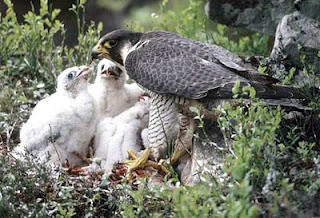Peregrine Falcons are breeding in Suffolk again – for the first time in a staggering 200 years.
The sensational birds of prey, which can hit 200mph in a dive, last thrived in the East Anglian county when King George III was on the throne and Napoleon was rampaging across Europe.
 Now a peregrine is sitting on four precious eggs under the Orwell Bridge – just feet away from an endless stream of lorries and cars thundering along the A14.
Now a peregrine is sitting on four precious eggs under the Orwell Bridge – just feet away from an endless stream of lorries and cars thundering along the A14.
The fastest living creature on earth last bred in Suffolk in the steeple of the parish church at Corton, near Lowestoft, in the early 1800s as Beethoven finished his first symphony.
Steve Piotrowski, (CRRCT), president of Suffolk Ornithologists Group and ornithological adviser to the Suffolk Wildlife Trust, said he was delighted the supreme predators had finally returned.
He said: “Peregrines normally nest on sheer rock faces in mountainous areas. But in recent years, with better protection and conservation measures in place, they have been increasingly venturing into towns and cities to nest on high-rise buildings, power stations, electricity pylons and the like.
It is perhaps not surprising they have chosen to nest on Suffolk’s highest structure – the Orwell Bridge. A pair began to spend the winter on the bridge in 1991 and there have been peregrines in the area ever since.”
He added: “The view from the bridge gives the falcons a distinct advantage and they are able to swoop down on unsuspecting pigeons and wading birds that feed on the mudflats below. Their prolonged stay raised speculation among local ornithologists that breeding would soon take place.
The birds’ presence caused great excitement locally and their spectacular displays became a feature of a day’s birdwatching on the Orwell estuary. The Suffolk Ornithologists Group campaigned tirelessly to have a nest box erected in the hope that breeding would take place and one was put up on the bridge in the early 1990s. The group’s success was largely down to one of our members, Gary Lowe, and we and the birds are now indebted to him.”
Gary, of Boyton, near Woodbridge, worked for Ipswich Borough Council’s estates department at the time but was also a council park ranger.
He negotiated with the Department of Transport over the provision of the box as a compensatory measure for a compound placed on the council’s Pipers Vale public open space related to works on the bridge.
 A peregrine is sitting on four precious eggs under the Orwell BridgeThe nest box the peregrines are using is the original one, paid for by the department.
A peregrine is sitting on four precious eggs under the Orwell BridgeThe nest box the peregrines are using is the original one, paid for by the department.
Mr Lowe, who now works for NPS property consultants, said: “The news that the peregrines are breeding in the box is fantastic. It has been a long wait but it’s worth it, especially if the peregrines manage to raise some young to the fledging stage. I hope it’s the start of a more widespread recolonisation in Suffolk as peregrines are such magnificent birds and they have had some lean times in the past.”
The birds have been studied closely by bird-of-prey enthusiast Rod Plowman, of nearby Chelmondiston. Rod said: “It is really exciting to think that peregrines are breeding with us again after such a long absence. They are spectacular birds and seem to be feeding mainly on the feral pigeons around the Ipswich docks area and the numerous wading birds that use the Orwell estuary.”
The peregrine chicks are due to hatch any day and conservationists expect many members of the public will want to see the adults hunting to feed them.
Mick Wright, Suffolk Wildlife Trust’s officer for the Orwell estuary, said the best vantage point would be the nearby Piper’s Vale country park on the north bank of the river.
He said: “There is plenty of car parking space there and the park offers good views of the bridge and the estuary. It would be wonderful if this pair of peregrines help to show people how important the Orwell estuary is for wildlife and encourages them to show respect for the area while enjoying its natural spectacle.”
Source: www.dailymail.co.uk









